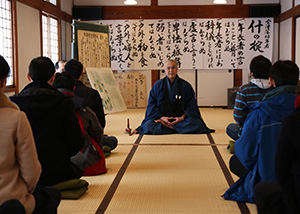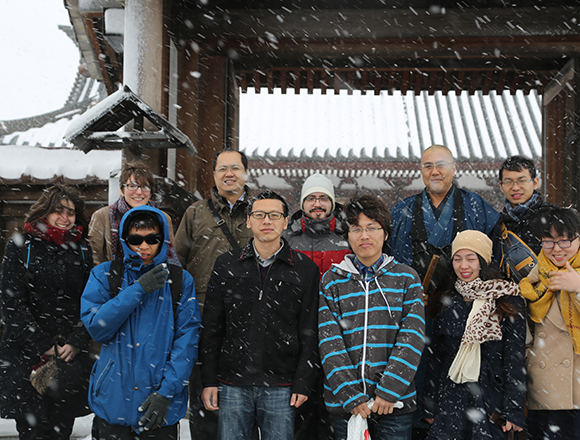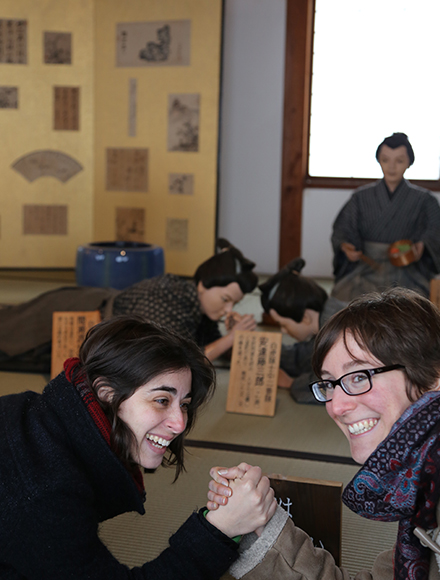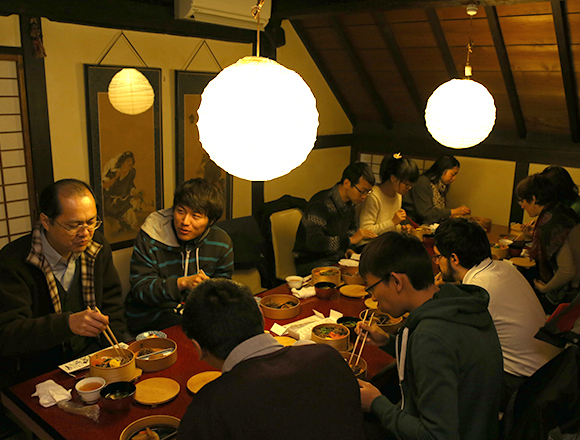- HOME
- Campus News: Aizu tour [The frozen samurai]
Campus NewsAizu tour:
The frozen samurai


Each year the International Education and Exchange Division of the School of Engineering of Tohoku University organizes a one-day trip around Sendai for foreign students of the School of Engineering. Actually, Japanese students are also welcomed. This year, students and staff members went to the Aizu basin. The region is located in Fukushima Prefecture. Since it is located 100 km west of the crippled Fukushima nuclear power plant and is separated from the power plant by a mountain range of over 2000 meters in height, the Aizu region has received a very small amount of radioactive fallout. The radiation level has almost returned to its level prior this tragic event and so is not a health hazard at all.

The main city of the region, Aizuwakamatsu, is well-known in Japan for its sake, lacquer objects and the famous Akabeko, a toy of red cow made of papier-mâché, the head of which bobs up and down when the cow is moved. Aizuwakamatsu is also well known for its long samurai tradition, which can be explored through the visit of the Tsuruga Castle, samurai houses and the Nisshinkan Samurai School. In 1868, Tsuruga Castle was the site of deadly battles between the last samurais loyal the Tokugawa shogunate and the newly formed Meiji government. It finally ended with the surrender of the samurais and the complete destruction of the castle in 1874. The existing castle is a reconstruction. Inside, there is a samurai museum that can be visited.

Our trip started from Sendai with a clear sky over our head. However, while we were cruising towards our destination we were unlucky to encounter unexpected cold and snowfall. We finally reached Nisshinkan, the famous old samurai school located a few kilometers north of Aizuwakamatsu. The school was founded in 1803 to educate youth. The children were sent at the age of 10 to undertake various courses such as astronomy, mathematics, martial arts and even swimming. In fact, in the middle of the school there is a swimming pool, the first one in Japan! Actually, the school burnt down in 1868 and what we can visit today is an accurate reconstruction. Visitors to the school can also experience some disciplines the pupils were studying at that time, such as archery and tea ceremony. We decided to give meditation, called zazen in Japanese, a try. The Buddhist monk explained the proper way to do zazen and its purpose. The first try lasted 8 minutes. We then meditated for 15 minutes. That is quite long and can be painful after few minutes if you do not correctly flex your leg muscles. The challenge and the reward of meditation is to completely empty your mind from any thought (such as pain in the legs!!!! How much time is left before the end!!!), disconnect the mind from the body and finally feel lightness, harmony and experience being as one with everything. After that, we moved downtown to have wappameshi for lunch. This dish consists of rice topped with seasonal local ingredients of the Aizu region. Wappa is actually the name for the round lunchbox, which is made of a thin sheet of curved wood. This time it was rice with a slice of salmon, mushrooms and some other wild vegetables. It was excellent! Afterwards we went to Ouchijuku, which is south of Aizuwakamatsu. This is a very nice former post town with thick traditional thatched buildings lined up along the main unpaved street. It has been restored to appear like it was during the Edo period. Brown colored icicles formations were hanging from all the thatched roofs, giving a feeling of warmth even though it was snowing. The group walked up the main street, had some food and hot amazake, a traditional sweet Japanese non-alcoholic drink made of fermented rice. We then returned to the bus and finished our journey. A nice warm weather welcomed us home.
